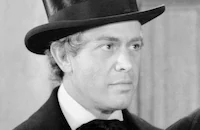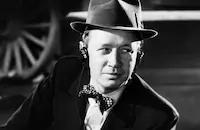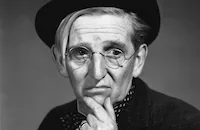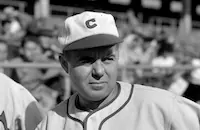The Lady Is Willing

Brief Synopsis
Cast & Crew
Marlene Dietrich
Fred Macmurray
Aline Macmahon
Stanley Ridges
Arline Judge
Roger Clark
Film Details
Technical Specs

Synopsis
When Broadway actress Elizabeth "Liza" Madden finds an abandoned baby in an apartment house, she impulsively decides to adopt the infant and takes it home. Liza then summons Corey T. McBain, a prominent pediatrician, to examine the foundling. When the doctor arrives, he shocks Liza by brusquely declaring that he detests all infants. After Liza announces her intention to adopt the baby, whom she names "Corey," her business manager, Kenneth Hanline, advises her to return the baby because the courts will never grant custody to a financially insolvent, unmarried woman. Although Liza maintains a lavish apartment, she has generously dispensed her earnings to friends and colleagues and hence has no money. Ken's dire prediction that Liza could spend her life behind bars for kidnapping threatens to come true when Sgt. Barnes of the New York police department and Mrs. Cummings of the child welfare bureau knock on Liza's door in search of the woman who spirited the baby from the apartment building. Although Liza tries to hide the infant from the authorities, her building manager inadvertently discloses Corey's presence by informing Liza that she has been granted permission to build a nursery in the adjoining apartment. Feeling sorry for the distraught Liza, Mrs. Cummings allows her to keep the infant until the next morning. Following Ken's advice, Liza decides to embark on a marriage of convenience in order to adopt Corey. That evening, when the baby develops a rash, Liza again sends for McBain, who is amused by her devotion to the infant. Afterward, when McBain confides that his true passion is research and that he became a baby doctor only for the monetary rewards, Liza relates her problems with the child welfare bureau and proposes a marriage of convenience. In exchange for a marriage certificate, Liza offers McBain her newly expanded apartment in which to raise rabbits for his research experiments, and he reluctantly accepts. After the wedding ceremony, McBain encounters his ex-wife Frances, who warns her successor about the doctor's obsession with rabbits. McBain abandons his medical practice to raise rabbits and bliss reigns in the household until one day, Joe and Nellie Quig appear, accompanied by their lawyer, K. K. Miller. Miller claims that the Quigs are Corey's real parents and offers to relinquish custody for $25,000, but McBain exposes the Quigs and their attorney as frauds. In celebration, McBain invites Liza to dinner and they end the evening with a passionate kiss. The next morning, the fortune-hunting Frances, having read about the $5,000 research grant awarded to McBain, visits him in his bedroom to ask for $500. When Liza discovers Frances in McBain's bed, she thinks that they are having an affair and angrily decides to close her show that night and move it to Boston. As Liza, her assistant Buddy, her maid Mary Lou and Myrtle, the nanny, scramble to prepare for their trip, the baby falls ill and Liza sends for the house physician to examine him. McBain becomes concerned when he sees the doctor enter the apartment, but Liza refuses to allow him to see the baby. Assured by the doctor that Corey has only a minor cold, Liza leaves for Boston with Corey and her entourage. Upon discovering that Corey has fallen seriously ill and is hospitalized in Boston, McBain books passage on the next flight. Meanwhile, in Boston, the doctors want to operate on the baby, but Liza withholds permission until she is able to contact McBain. After Liza's frantic calls to New York go unanswered, she paces the hospital corridor in anguish. When McBain finally appears, she flies into his arms, full of remorse. After examining Corey, McBain affirms the need for surgery, but is reluctant to perform the operation himself. When Liza begs McBain to operate and promises to love him no matter what the outcome, he consents. Hours after the surgery has been completed, the baby's condition remains unchanged, and McBain insists that Liza go on with her performance at the theater. At the finale, McBain appears in the wings with the good news that the baby will recover.

Cast

Marlene Dietrich

Fred Macmurray

Aline Macmahon

Stanley Ridges

Arline Judge
Roger Clark
Marietta Canty
David James
Ruth Ford

Harvey Stephens
Harry Shannon

Elizabeth Risdon

Charles Lane
Murray Alper
Kitty Kelly

Sterling Holloway
Chester Clute
Robert Emmett Keane

Eddie Acuff
Myrtle Anderson
Lorna Dunn
Eugene Borden
Judith Linden

Neil Hamilton
Helen Ainsworth
Lou Fulton
Billy Newell

Jimmy Conlin

Charles Halton
Romaine Callender

Ray Walker
Ernie Adams
Roy Crane
Georgia Backus
Frances Morris
Paul Oman

Edward Mcwade
Crew
Francisco Alonso
Lionel Banks
Bud Brill
Gordon Clifford
Lodge Cunningham
Douglas Dean
Paul Flato
John Frederics
James Edward Grant
James Edward Grant
W. Franke Harling
Irene
Jack King
Mitchell Leisen
Albert Mccleery
Rudolph Sternad
M. W. Stoloff
Ted Tetzlaff
Eda Warren

Videos
Movie Clip


Film Details
Technical Specs

Articles
The Lady is Willing
Production began on August 11th and two weeks later on August 25th, Dietrich suffered an injury on the set. Director Mitchell Leisen remembered later, "We had only been shooting a few days when she hurt her foot. She was very late that morning because she said her astrologer, Carroll Righter, had predicted that she'd have an accident that day. She made her chauffeur drive very slowly to the studio just to be on the safe side. We started in, and she picked up one of the twins who were being used for the baby. I didn't see exactly what happened, but she was walking behind the couch and tripped on a little red wagon. As she fell, she turned herself over so she landed on her back with the baby on top of her, and in doing so, she cracked the little bone of her ankle. It must have been very painful for her, but there was never any question of recasting. She got some orthopedic shoes and we went right on. We had to trick it up a little so that the audience wouldn't see her limp. The set had a mirrored wall, so every time she had to cross the room, we'd start her out with one step on her good foot, then cut to a reaction shot of Fred [MacMurray, Dietrich's co-star] sitting on the couch with the reflection of her double in the mirror behind him crossing the room. Then we cut back to Marlene as she was arriving and she took one step into the scene with her good foot. We could always angle the camera so it wouldn't photograph itself in the mirror, but putting the lights where Marlene wanted them and not picking them up in the mirror was sometimes very hard."
Dietrich ended up in a cast but it didn't stop her in her single-minded pursuit of the happily married and notoriously faithful MacMurray. For most of her career Dietrich had made it a habit to seduce her leading men and her track record was excellent, which is why she couldn't understand how MacMurray could be immune to her charms. When she complained to Leisen about it, he said, "Listen, Marlene, Fred's so much in love with his wife Lilly, he couldn't care less about any other woman, so you lay off. Just make the picture." MacMurray later said, "I had never had anything like this happen on a picture before and it was very embarrassing."
The Lady Is Willing turned out to be an embarrassment as well. Bosley Crowther hit the nail on the head when he wrote in his April 24, 1942 New York Times review, " Why do the great minds get these notions that glamour ladies must sometimes throb with mother-love? And why, when they do, is it usual to dig up the same old yarn? Miss Dietrich was rolling along nicely as an eminently unmaternal femme fatale. Why should she suddenly go all mushy over a baby she finds on Eighth Avenue? Why should she, in her silken finery, bring it home to her sumptuous diggings, and then, in order to adopt it, should she have to make a marriage of convenience with Fred MacMurray, a highly successful baby-doctor who prefers research to pediatrics? Didn't she know any other fellows? Why should the two then fall in love, why fight and finally reconcile when the baby comes down with mastoiditis and only Dr. MacMurray can pull it through? The answers are obvious but not sufficient. Same goes for the telling of the tale. Where it should be tender and simple it is maudlin and over-dressed. And where the romantic business should be delicate it is coarse and lickerish. Miss Dietrich makes an unbelievable mama; her eyes are more for the camera than for the bairn. And Mr. MacMurray's ardor is decidedly on the casual side. Aline MacMahon and Stanley Ridges do well in supporting roles, and one-year-old David James is adorable as the tot. But he deserved a better screen mother. The lady is too willing and not sufficiently sincere."
Producers: Charles K. Feldman, Mitchell Leisen
Director: Mitchell Leisen
Screenplay: Albert McCleery, James Edward Grant (and story too)
Cinematography: Ted Tetzlaff
Art Direction: Rudolph Sternad, Lionel Banks (supervising art director)
Music: W. Franke Harling
Film Editing: Eda Warren
Cast: Marlene Dietrich (Elizabeth 'Liza' Madden), Fred MacMurray (Dr. Corey T. McBain), Aline MacMahon (Buddy), Stanley Ridges (Kenneth Hanline), Arline Judge (Frances), Roger Clark (Victor), Marietta Canty (Mary Lou), David James (baby Corey), Ruth Ford (Myrtle), Harvey Stephens (Dr. Golding), Harry Shannon (Detective Sergeant Barnes).
BW-91m.
by Lorraine LoBianco
SOURCES:
The AFI Catalog of Feature Films
The Internet Movie Database
The New York Times: The Lady Is Willing by Bosley Crowther, April 24, 1942
Mitchell Leisen: Hollywood Director by David Chierichetti

The Lady is Willing
Quotes
Trivia
Notes
The working title of this film was Miss Madden Is Willing. The film opens with a sequence in which an audience is seen waiting in line outside a theater. The opening credits are then printed on the theater marquee and playbill. As the audience is waiting, Marlene Dietrich comes out of the theater, climbs into a taxi and tells the driver her destination. This was an early example of screen credits running simultaneous to the beginning action of the story. According to a mid-September 1941 Hollywood Reporter news item, Dietrich sprained her ankle during production and had to finish the picture wearing a cast. Fred MacMurray was borrowed from Paramount to appear in this picture. On March 3, 1943, Lux Radio Theatre broadcast a radio version of the story, starring Kay Francis.














